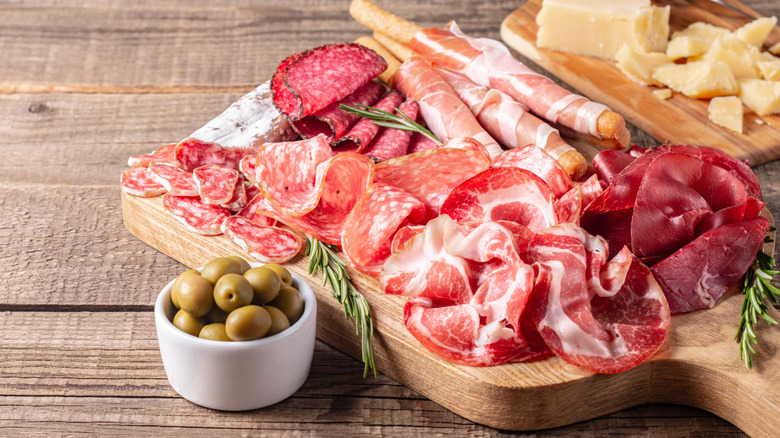One Common Cleaning Mistake Will Seriously Ruin Your Charcuterie Board
Charcuterie boards are an art for those who take snacking very seriously. The limits of what can be created and served at any event are endless, and one can never have enough fun-shaped boards ready to hold the makings of an elegant adult Lunchable. When it comes to clean up, however, there's a common mistake you're likely making with your charcuterie boards. No matter what kind of grime has found itself bound to the wood, never soak your charcuterie board in water, or bleach.
Soaking a charcuterie board in water or bleach can result in a warped or cracked board. Dirty, cracked charcuterie boards have ideal spaces for harmful bacteria that can spread foodborne illness. Because of this, avoiding cracks is a vital safety rule for charcuterie boards. This means never leaving your charcuterie board in the sink overnight — and certainly avoid putting it in the dishwasher. Don't worry too much, though, because when there's a wrong way to do something, there's also a right way, and cleaning a charcuterie board in a way that prevents bacteria growth is an easy process.
How to properly clean a charcuterie board
Step one for cleaning a wooden charcuterie board is just to make sure you're cleaning is as soon as possible. That can be immediately after everyone goes home, or after you've had a night's rest. Rinse the dirty charcuterie board in warm water and use dish soap and a gentle sponge or cloth to scrub the board and any debris clinging to it. Don't use a harsh sponge or steel wool, as it can damage the surface of the board.
You can disinfect the board by using white vinegar mixed with water, or lemon juice. Rinse the board with water and towel dry the excess water before letting it air dry the rest of the way. A lot of food goes on charcuterie boards, and something will probably leave a stain at one point or another. You can work stains out by sprinkling salt, then rubbing half a lemon on the surface so the acidity can remove the mark.
Once your board is completely dry, it's important to oil it. Use a food-grade mineral oil and beeswax and apply it to the surface of your board. Not only will this help it look brand new, but it also creates a protective barrier between the food and the wood to prevent the growth and spread of bacteria. Now that you know to refrain from soaking, it's time to acknowledge that you've likely been cleaning your wooden cutting board wrong as well.

